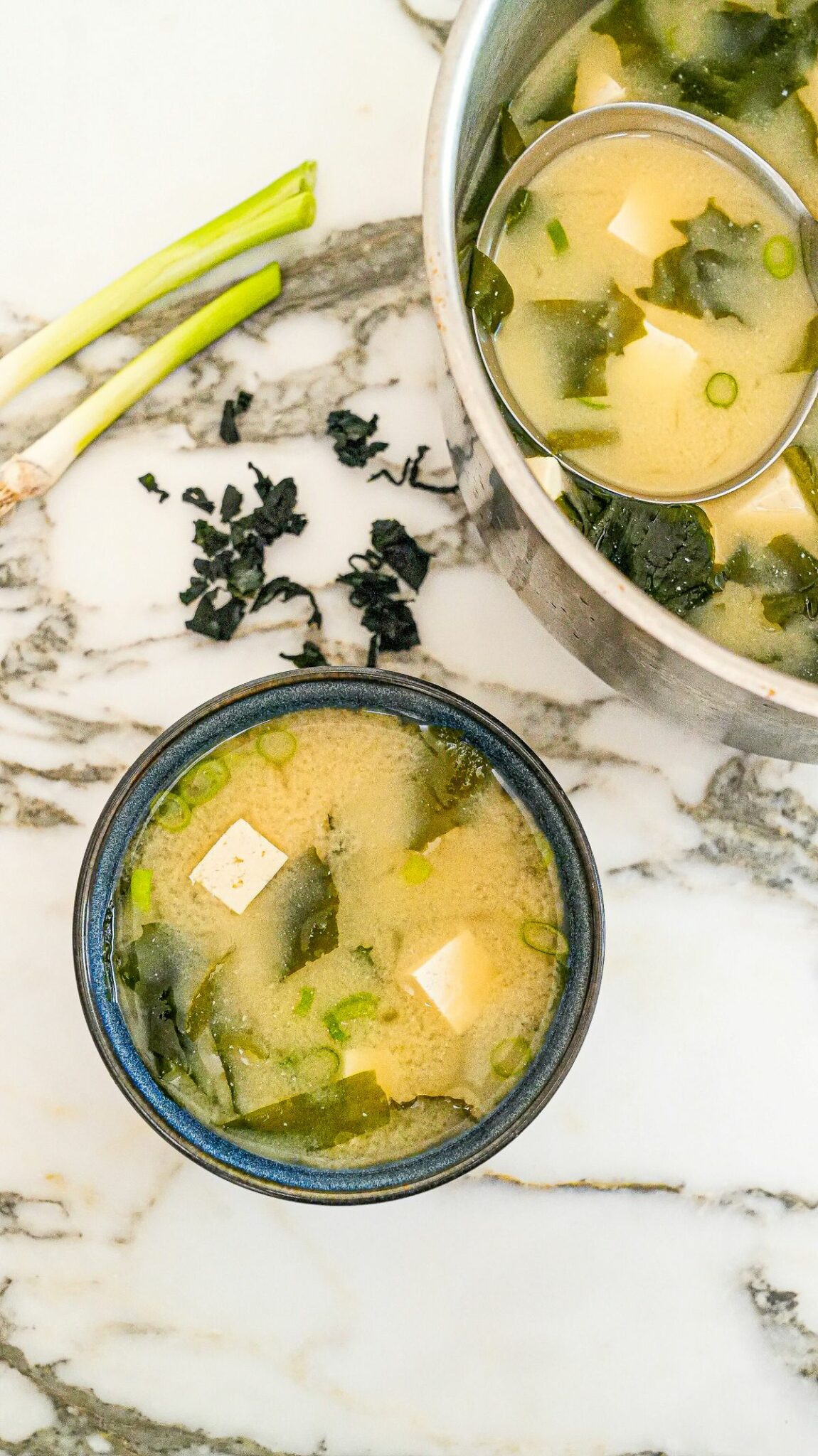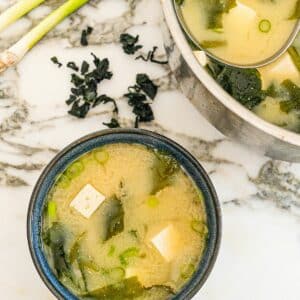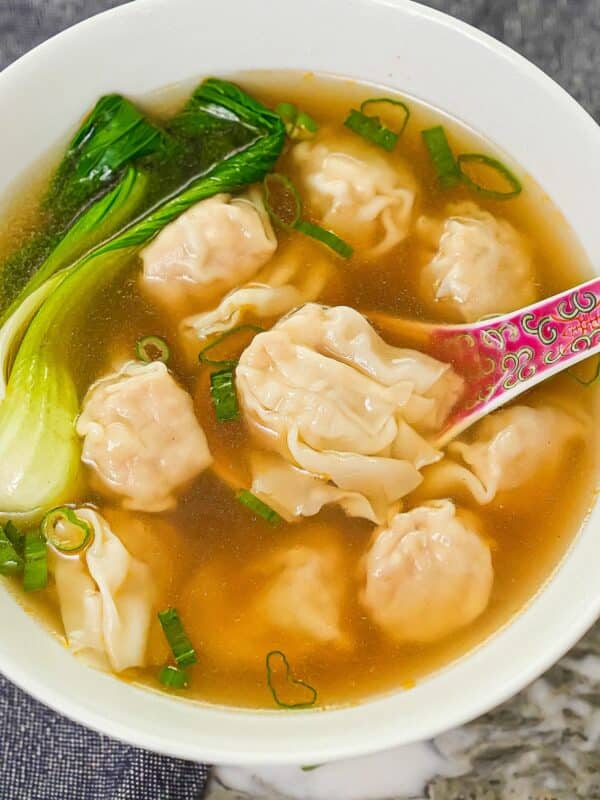Authentic Miso Soup – 15 Min! (VIDEO)
This post may contain affiliate links. Please read our disclosure policy.
Authentic Miso Soup only takes 15 minutes and is so easy to make! It is simple but SO delicious – warm, comforting, and full of savory flavor!

Watch the Miso Soup Recipe Video Below!
A Note from CJ

Authentic Miso Soup is so easy to make!
You’d be shocked to learn how quick and easy it is to make authentic Miso Soup at home! I love making it alongside my favorite Japanese dishes like Chicken Karaage (or Air Fryer Chicken Karaage), Chicken Katsu (Air Fryer Chicken Katsu) or Pork Katsu alongside homemade Tonkatsu Sauce and (hibachi) Benihana Fried Rice!
If you love soup, try Egg Drop Soup, Hot and Sour Soup, or Wonton Soup / Wonton Noodle Soup!
Ingredient Tips
Refer to the recipe card for the full list of ingredients and measurements!
- kombu (dried kelp) and dried bonito flakes – these two ingredients are to make dashi (stock). You can also make dashi with a dashi packet, dashi powder or liquid dashi (if using liquid dashi, use the same measurements as the recipe calls for water).
- red or white miso paste – Miso (味噌) is an ingredient made from fermenting soybeans that is used commonly in Japanese cooking. The most common types are white (shiro), red (aka), and brown (genmai).
- dried wakame seaweed – these are sold in dried pieces; they’ll expand significantly when rehydrated in the soup, so you don’t need a lot!
- firm or extra firm tofu, cubed – use firm tofu, as anything softer will disintegrate in soup.
How to Make Miso Soup
Cook the Kombu Add Flavor the Dashi Broth – In a pot add the water and kombu and heat over high heat until the water just begins to bubble. Turn the heat to medium low and let the kombu cook for 10 minutes until the kombu has just softened and remove. Add the bonito flakes or hondashi powder. Bring to a boil and simmer for 15-20 seconds until the powder has dissolved or the flavor from the flakes have been extracted into the broth. Strain the bonito flakes if using (no need to strain if using hondashi powder).
Mix Miso, Add Tofu, Seaweed, and Scallions – Mix the miso paste into the broth and mix using a whisk until dissolved. Alternatively, press the miso paste through a fine mesh strainer. Add the cubed tofu, dried wakame seaweed and scallions to the broth. Heat over medium heat until the seaweed has been rehydrated and the tofu is warmed through. Serve immediately and enjoy!

PRO TIPS
CJ’s Recipe & Storage Tips
Do not overcook the kombu, otherwise it will be slimy and turn bitter!
Use a whisk or fine mesh strainer – Miso can be tricky to mix completely into the dashi – I recommend either mixing the miso paste into the broth with a whisk or press the miso paste through a fine mesh strainer.
Storage – If possible, I recommend storing the Miso Soup and add-ins (seaweed, tofu, scallions) in separate airtight containers in the refrigerator. Separating the Miso Soup and condiments ensures that the toppings do not get water logged in the refrigerator. If you store them all together, that’s okay but you may notice the add-ins become soggy. Reheat until warmed through on the stove or in the microwave.
If you tried this Miso Soup Recipe or any other recipe on my website, please leave a 🌟 star rating and let me know how it went in the comments below!
Miso Soup – Easy and Authentic! (VIDEO)

Equipment
Ingredients
Dashi Stock
- 5 cups water
- 1 piece kombu, dried kelp
- 1 packed cup dried bonito flakes, or 1 tablespoon hondashi powder
Miso Soup + Toppings
- 4 tablespoons red or white miso paste
- 1 package firm or extra firm tofu, cubed
- ¼ cup dried wakame seaweed
- 2 scallions, thinly sliced (whites and greens)
Instructions
- In a pot add the water and kombu and heat over high heat until the water just begins to bubble. Turn the heat to medium low and let the kombu cook for 10 minutes until the kombu has just softened and remove. Do not overcook the kombu, otherwise it will be slimy and turn bitter.
- Add the bonito flakes or hondashi powder. Bring to a boil and simmer for 15-20 seconds until the powder has dissolved or the flavor from the flakes have been extracted into the broth. If using bonito flakes, use a fine mesh strainer to strain out the bonito flakes into a large measuring cup.
- Mix the miso paste into the broth and mix using a whisk until dissolved. Alternatively, press the miso paste through a fine mesh strainer.
- Add the cubed tofu, dried wakame seaweed and scallions to the broth. Heat over medium heat until the seaweed has been rehydrated and the tofu is warmed through. Serve immediately and enjoy!
Video
Notes
Nutrition
Nutrition information is automatically calculated, so should only be used as an approximation.
This Miso Soup recipe was originally published in August 2024, and updated in November 2025.











